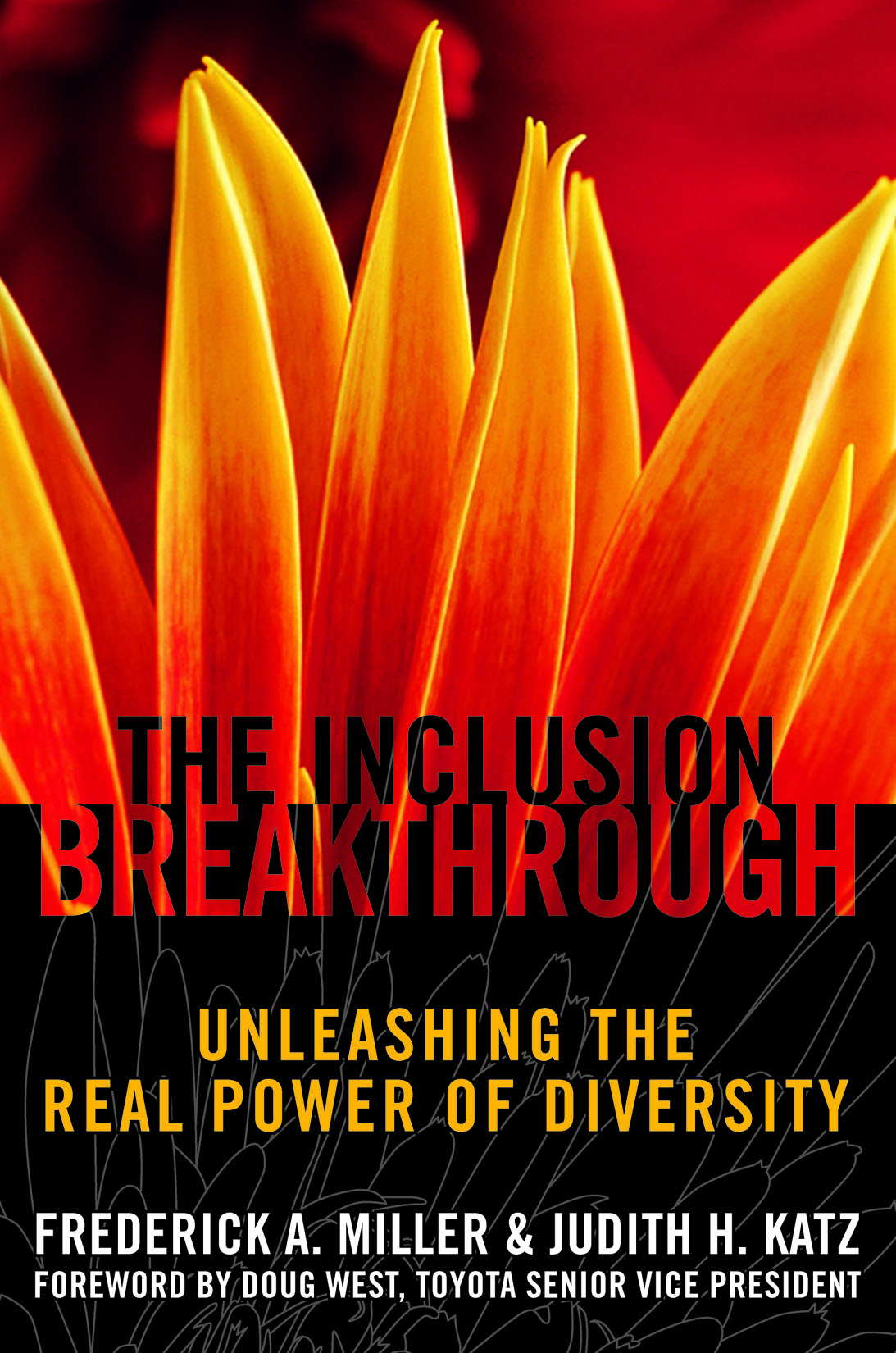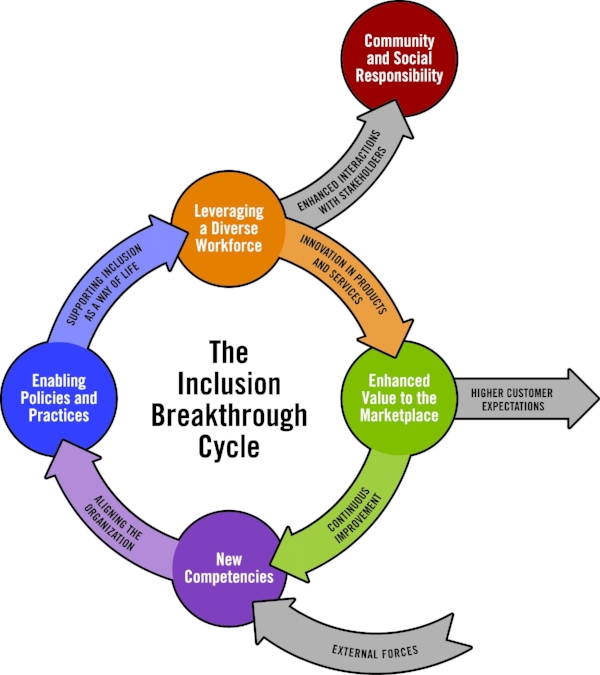The Need for an Inclusion Breakthrough
Organizations today are being forces to live by their wits. Their survival depends on their ability to out-think their competition, which can only be accomplished by catalyzing the intellectual resources of their people into creative new solutions. A single person's brilliance or a single group's point of view is no longer enough to sustain an organization's growth in the face of global competition. Tomorrow's successful organizations will be those that harness the collective and synergetic brilliance of all their people, not just an elite few. The stock-market stars will be the organizations that capitalize on the diversity of their workforce.
But capitalizing on diversity requires more than simply hiring a diverse workforce. Radical changes are needed also in both the structure and the culture of most organizations—in their policies and practices, the skills and styles of their leaders, and day-to-day interactions among all their people.
Many organizations will fail to make these changes because the changes seem too radical. Those organizations will not survive. To many people and most organizations, diversity seems like a problem, not a solution. Differences are to be avoided, not embraced and utilized. Age-old hierarchies, traditions and biases must not be questioned or examined. To make these changes to embrace and capitalize on diversity will require a true breakthrough—an Inclusion Breakthrough.
The first step is to ensure that diversity is seen as mission critical. When the current and future success of the organization is tied directly to the need for diversity, it becomes a powerful tool for organizational change and higher performance. Making diversity mission critical conveys its urgent mature to every person in the organization and positions the organization to reap the benefits from leveraging that diversity.
An organization that leverages diversity enables all members of its workforce to utilize their full portfolio of skills and talents. It continually seeks to broaden its diversity to take advantage of new markets, new sources of innovation, and new pathways to success.
“The ‘Inclusion Breakthrough Strategy’ works! We used it in a business group of 6,000+ employees...one small unit came up with eight innovative processes in one year that helped improve the unit’s profitability by $31,000,000. This book should be a practitioner’s bible.”
The Inclusion Breakthrough is a must-read for anyone interested in accelerating their diversity work to achieve higher operational performance.
Read more about The Inclusion Breakthrough below or click here to purchase the book. For an excerpt from the book click here.
The Elements of an Inclusion Breakthrough
Some organizations talk about the bold actions needed to unleash the potential of their workforce and about capitalizing on diversity to deliver higher value to the marketplace. Few, however, attempt to use differences as strategic assets critical to maximizing competitive advantages. Even fewer take advantage of the opportunities diversity provides for its workforce, marketplace, community, and customers. Leveraging diversity creates the opportunity to improve everyone's performance, enhancing the organization's capability to innovate and serve all its customers and constituents and succeed in the twenty-first century.
The inclusion breakthrough cycle examines key components for leveraging diversity and creating a culture of inclusion by focusing on five key elements as shown below:
- New competencies
- Enabling policies and practices
- Leveraging a diverse workforce
- Community and social responsibility
- Enhanced value to a diverse marketplace
The Inclusion Breakthrough Cycle
New Competencies
In most organizations, external forces affect what is required of leaders, of teams and in fact of everyone. Everyone's competencies must be enhanced to enable the organization to leverage all its talent and to respond to an ever-changing and demanding environment. The skill sets needed to build a culture of inclusion must be identified, developed, and practiced. The organization need to establish new definitions of competency for every level and every person, and then realign itself to create an environment that holds people accountable for new behaviors and competencies. Everyone needs to work to create a more inclusive culture, and everyone must be rewarded for such behaviors.
The organizations needs to develop and maintain the more diverse talent base required to accomplish the organization's mission in today's world. The organization needs to develop norms that enhance innovation, problem solving and creativity so that the combined wisdom of the entire workforce is leveraged for enhanced process effectiveness and higher organizational performance. After these new behaviors are identified and developed the next step is to align the organization's policies and practices.
Enabling Policies and Practices
To sustain a culture of inclusion, and organization needs to create a new set of policies and practices that not only support new competencies but also create the environment that enables all people to do their best work. An organization's structures, both formal and informal, have a great deal to do with a person's ability to contribute. Many organizations have best practice policies but get failing marks for implementation. In too many organizations, stated and written policies are not congruent with actual practices and behaviors. Some practices to align are policies for promotions, performance managemnt, succession planning, development opportunities, mentoring and coaching, and flexible childcare and eldercare options. POlocies such as domestic partner benefits and extended parental leave also influence a person's sense of inclusion. To achieve a culture of inclusion, the bar must be raised on all policies and practices. This new baseline of inclusion supports the leveraging and unleashing of diversity.
Leveraging a Diverse Workforce
A real test of inclusion breakthrough is unleashing the power of dversity by making it a way of life in the organization. The real power of diversity is found in creating a new mutualism, a new "we," that benfits both the individual and the enterprise. When an organization unleashes the power of diveristy, striving for samenewss and monoculturalism gives way to a more productive atmoshpere of creativity and innovation. The workforce needs to become an ever-higher-performing one, comprised of partnerships and teams whose diversity works for them, not against them. Retention and recruitment efforts must develop, insprie, and enable each person, from every background and experience, to do her or his best work in service to the mission of the organization.
Community and Social Responsibility
As organizations unleash the power of diversity internally, many individuals desire to extend that energy, innovation, and learning beyond the organization to their families, the community, and other personal and professional interactions. Organizations also extend the effort beyond their walls and begin to establish true partnerships with the communities in which they operate. They need to be clear about their intent and about the values they will bring to partnerships. Organizations are affected by what is happening outside their front doors. Neighborhoods, cities, states, and nations influence an organization's success as never before. Organizations need to have a strategy to help build sustainable local and national communities in which to do business.
Many organizations are stepping up to the challenge of becomin socially responsible, both as a srategic need—to become known in the community as a good place to work, thus becoming a magnet for talent—and to be differentiated in the marketplace.
Enhanced Value to the Marketplace
Many organizations are being challenged to create new kinds of partnerships with suppliers, distributors, customers, and constituents because the marketplace and their clientele have changed. Individuals and groups that have been excluded from supplier, distributor, and customer bases for a variety of reasons in the past have now become a critical market segment. And as a part of delivering enhanced value to the marketplace, organizations must be better able to engage a customer base with ever-increasing expectations about service, quality, and innovative products and advertising.
The key to having a successful breakthrough is incorporating and implementing it in a organization's overall business strategy and delivering enhanced products and services to the marketplace, customers, constituents, and other key stakeholders. One outcome of delivering enhanced value to the marketplace is that customers come to expect a new level of value, not only from the organization but from others as well. This higher expectation feeds the need for organizations to continuously improve and find more innovative solutions, products and services to meet customers needs.
And the learnin process doesn't stop there. The marketplace and clientele, as well as the organization's relationship with them, trigger new strategies that the organization hadn't considered or once deemed unattainable. Thus, the circle comes around again, providing continuous learning and improvement, leading to an ongoing cycle that supports organizational readiness for change.
“The Inclusion Breakthrough is a ‘must read’ for organizations that want to move diversity work to a new level.”
“[The Inclusion Breakthrough] not only acknowledges the importance of business practices that respect people, communities, and the environment, it makes the case that social awareness is a critical business need for organizations of the future.”
“For individuals interested in implementing a comprehensive, sustainable ‘inclusion’ approach to work force diversity, The Inclusion Breakthrough: Unleashing the Real Power of Diversity should prove valuable. It addresses two concerns that challenge most diversity thrusts: comprehensiveness and sustainability.”



